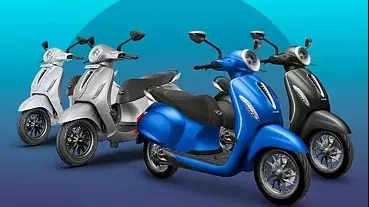
New Delhi: India’s biggest internal combustion engine (ICE) two- wheeler manufacturers have climbed on to the electric vehicle bandwagon. At least two of them – Bajaj Auto and TVS Motor Company – have also started elbowing out pure-play e2W companies through a mix of aggressive product launches and ramping up of distribution at lightning speed.
But margin gains and volume share within the overall product portfolio of EVs are still small. And the EV production lines of the ICE OEMs continue to run from the profits they make by selling petrol scooters and motorcycles. This was despite subsidies which have been available under the government’s FAME (Faster Adoption and Manufacturing of Electric Vehicles) scheme, the second edition of which ends in March this year.
Take the TVS example. CEO K N Radhakrishnan said during a call with analysts last week that while margins from the fast-growing EV business were “positive” but not so “at the company level” yet. Overall, TVS reported 68% increase in net profit to INR 593 crore, with EBITDA margin growth of 110 basis points year on year to 11.2%. And Radhakrishnan said that the company was availing subsidies under FAME II.
In any case, EV margins should improve as volumes trickle in and for that, ICE companies will need to make massive investments not just in the product pipeline but also in distribution and supply chains. Radhakrishnan spelled out the company’s strategy for cornering more share of the market from others: volume, growth, premiumisation, robust supply chain and new variants. TVS is eyeing a doubling of sales of its iQube electric scooter in each quarter over the previous year and hopes to close FY24 with total EV sales of one lakh units. The company will be launching multiple products in the next 4-6 quarters in the EV space. It already has three iQube variants in the market.
For Bajaj Auto too, the iconic Chetak electric has brought in remarkable sales numbers. In a call with analysts, Executive Director Rakesh Sharma said that Chetak has been posting good sales numbers despite a lot of discounting by competitors during the past few months. Wider distribution footprint, ensuring supply certainty after the company managed to tackle the earlier supply chain issues, and “the right price to the product” led to robust sales growth. “The sales network is now almost 160 cities. Wider geography is available to play with. Chetak has become competitive because it is now at almost equivalent pricing with competitors and getting good traction.” Of course, the new variant (Urbane) which was introduced earlier this month is also generating sales momentum and by Q1 of next year, one more electric product will be launched. But Bajaj’s bread and butter continues to be the ‘125cc plus’ segment of ICE vehicles, which account for 70% of the company’s retail volumes and where it claims over 30% market share.
Subsidy math:
Now the government is toying with the idea of launching another edition of the FAME scheme, but with significant variations. This could mean a massive reduction in subsidies available for e2W manufacturers. Margins of ICE companies from their respective EV businesses could get squeezed further. Any new FAME scheme may prioritise subsidising public transport over private vehicles.
Radhakrishnan said that the government will take a call on the architecture of the FAME scheme going forward, while pointing towards the correlation between rapid product acceptance by the customer, increase in retail volumes and how this process will provide the company the ability to relook at the cost structure for EVs. “Once we get the volumes up, I am very confident that over a period, there will be transformation in cell prices, cell cost, cell chemistry and other costs. Once the topline comes, every other line we can improve,” he said.
Bajaj and TVS have made inroads into the e2W market in a year which saw policy uncertainty with alleged subsidy misappropriation, subsequent reduction in subsidies and withdrawal of subsidies for some OEMs. The government was offering purchase subsidies under the FAME II scheme till allegations of misappropriation surfaced. OEMs which were denied subsidy subsequently and some, which were asked to pay back subsidies retrospectively, eventually suffered severe working capital shortages. This was one of the biggest reasons for the shakeup in the market share pecking order. Later in the year, policy uncertainty and dwindling sales led market leaders to offer massive discounts too. Except for Ola and Ather, almost all other pure-play e2W OEMs have seen significant sales volume decline during FY24.
Data from the Society of Manufacturers of Electric Vehicles (SMEV) shows that in 2022-2023, Bajaj had 5% market share, TVS was at 11% and Ola at 21%. But in the nine months till December 2023, Bajaj climbed to 10%, TVS to 20% while Ola was at 33%. In other words, by the end of 2023, Bajaj and TVS together accounted for every third e2W sold in the country, while Ola accounted for another third. And the market share gains of Bajaj and TVS are on the back of shrinking shares of pure-play e2W OEMs. Ampere, Okinawa and Hero Electric who were at 12%, 13% and 12% share of the market in 2022-2023. In other words, these three companies were accounting for more than a third of the entire e2W market last fiscal. But by December 2023, their shares had dwindled to 7%, 3% and 2% respectively or together, they accounted for just a little over tenth of the market.















